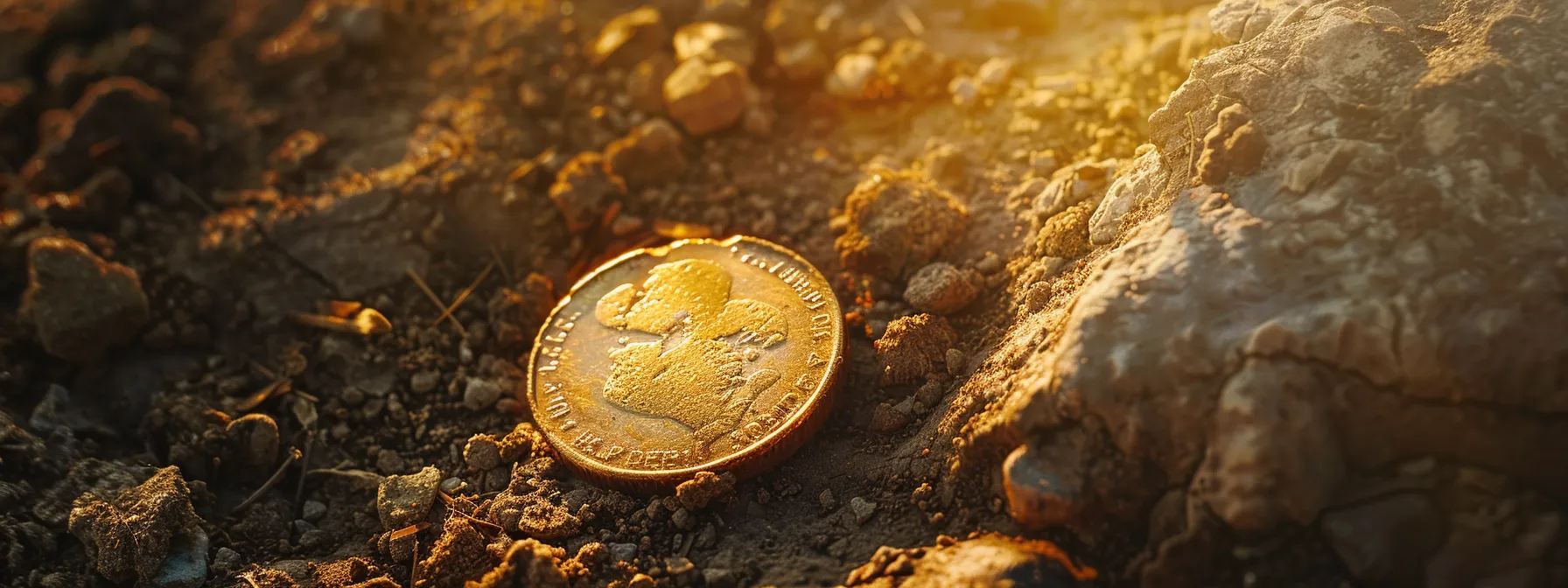

As a dedicated loot detective, I’ve learned that mastering the right swing techniques can significantly enhance your treasure hunting experience. Whether you’re after shiny coins or historical relics, the way you handle your metal detector makes all the difference. With these metal detecting tips, you’ll fine-tune your grip, swing path, and even adapt your techniques to varying soil conditions. Get ready to elevate your detecting game and uncover more hidden gems in your next outing. Keep reading to discover game-changing strategies that will improve your finds and boost your confidence!
Perfecting Your Grip for Enhanced Sensitivity and Control

When I set out for a day of metal detecting, one of the first metal detecting tips I focus on is my grip. Choosing the right handle for my detector can make a world of difference in comfort and control, especially when I’m out there searching for buried treasures or scouting for gold mining spots. I find that adjusting my grip position based on target depth helps me maintain sensitivity to signals while minimizing fatigue in my elbow. Practicing a relaxed yet firm grip allows me to feel even the slightest changes in what’s beneath the surface, ensuring that I won’t miss a potential find. With the right gear and technique from Loot Detective, I’ve upped my success rate during my adventures.
Choosing the Right Handle for Your Detector
Selecting the right handle for my metal detector significantly impacts my ability to dig into diverse types of soil. A comfortable grip allows me to swing my loot detective smoothly, whether I’m on a beach searching for unique artifacts or in a field exploring for meteorites and old mining tools. By finding a handle that suits my style, I can focus on the thrill of prospecting rather than battling discomfort as I sift through layers of earth.
Adjusting Grip Position Based on Target Depth
While I’m hunting for treasures, adjusting my grip based on the target depth is vital. When I detect a signal that indicates deeper objects, I often shift my grip to provide more control and stability, especially when the tide is rising. This helps prevent any pain in my arms from prolonged use metal detecting tips, allowing me to stay focused and increase my chances of finding something exciting, like those hidden pieces that could tell a story about Montpelier‘s past loot detective.
Practicing a Relaxed Yet Firm Grip
Finding the perfect grip while metal detecting is essential, especially when I’m on a gold prospecting mission in Kentucky. I focus on maintaining a relaxed yet firm grip that allows me to perform a smooth pendulum swing with my Equinox detector. This metal detecting tips loot detective not only heightens my sensitivity to different signals, including those pesky iron targets, but it also helps me conserve energy, making all-day searches more enjoyable.
| Grip Type | Benefits | Target Sensitivity |
|---|---|---|
| Relaxed Grip | Minimizes fatigue | High sensitivity to subtle changes |
| Firm Grip | Enhances control during swings | Better detection of deep or iron signals |
With your grip refined, you’re ready to take your detecting game to the next level. Let’s dive into how your swing path can amplify your coverage and help you uncover hidden treasures!
Optimizing Your Swing Path for Maximum Coverage

To truly enhance my hunting game, I pay close attention to my swinging techniques metal detecting tips. Establishing an efficient overlap between swings loot detective makes a significant difference in my finds, especially in sandy areas where signals can easily get lost. I adjust my swing path depending on the terrain I’m dealing with, whether it’s rocky or soft sand, to maximize my detector‘s effectiveness. Keeping a consistent swing height is also vital; I notice that varying my motion can cause some noise to go unnoticed. When I maintain steady rhythms with my arm, it creates a reliable pattern that helps me pick up on faint signals, leading to more successful treasure hunts.
Establishing an Efficient Overlap Between Swings
To improve my chances of finding treasures like gold nuggets, I focus on establishing an efficient overlap between my swings. I’ve learned that incorporating even a couple of inches into my swing path metal detecting tips dramatically increases my odds of detecting elusive signals buried beneath the surface. Whether I’m searching in an area rich with archaeology or feeling more adventurous under the sun, ensuring that each pass overlaps just right is key to not missing any potential finds.
| Technique | Benefit | Outcome |
|---|---|---|
| Overlap Swings | Greater area coverage | Higher chances of finding gold nuggets |
| Consistent Swing Height | Accurate signal detection | Better for very low frequency detection |
Adjusting the Swing Path in Diverse Terrain
Adjusting my swing path based on the terrain is essential for a successful hunt metal detecting tips. While searching fields where I expect to find silver coins or maybe even an old drink can, I make sure to keep my shoulder relaxed and my movements fluid. My knowledge and research into local environments guide my swing technique, helping me adapt to conditions that could hide treasures just beneath the surface.
The Importance of Consistent Swing Height
When I’m out in West Virginia, searching through old properties, maintaining a consistent swing height is key to my metal detecting tips success. I’ve noticed that when I pay close attention to my swing, I not only minimize the risk of missing antique treasures but also allow my machine to function at its best. This steady rhythm helps to ensure that even the faintest signals, which could lead to hidden gems, don’t slip through the cracks.
You’ve mastered the swing path, but now it’s time to take on the varying challenges of the ground beneath your feet. Adjusting your metal detecting tips speed can drastically impact your success, so let’s dive into how soil conditions influence your treasure hunting strategy!
Adapting Swing Speed to Different Soil Conditions

Swing speed is crucial when using my metal detector, especially since soil conditions can vary dramatically from one location to another. I’ve spent time learning metal detecting tips to identify different soil types, as they greatly influence how well my detector picks up signals from buried treasures. By modifying my swing speed to match the ground beneath my feet, I can optimize my chances of finding something valuable. Striking the right balance between speed and accuracy not only enhances my efficiency during hunts but also ensures I don’t miss out on those hidden gems that lie just below the surface. Each adjustment I make leads to better results, and the thrill of discovering something remarkable keeps me going.
Identifying Soil Types and Their Impact on Detection
When I’m out hunting, taking note of the soil type beneath my feet can make a real difference in my detection efforts. For example, sandy soils tend to allow signals to travel better, while clay soils can muffle sound, requiring me to adjust my metal detecting tips accordingly. I’ve learned that spending a few moments identifying the ground composition can lead to better results and more successful digs, increasing the overall enjoyment of my treasure hunting adventures.
How to Modify Swing Speed for Best Results
Every time I’m out treasure hunting, I pay close attention to the soil conditions beneath me. If I’m dealing with metal detecting tips ground, I can swing my detector faster because the signals tend to transmit clearly through the material. But when the ground turns hard or clayey, slowing down my swing allows me to capture the faintest sounds that might otherwise be lost.
| Soil Type | Recommended Swing Speed | Rationale |
|---|---|---|
| Sandy | Faster | Clear signal transmission |
| Clay | Slower | Better signal capture |
| Rocky | Moderate | Adjust based on obstructions |
By continually assessing the terrain, I can adapt my swing speed to improve my overall chances of uncovering valuable metal detecting tips. Each adjustment feels instinctive after a while, combining my experience and awareness of the environment to boost my results. This approach not only enhances my efficiency but also keeps the hunt exciting and rewarding.
Balancing Speed and Accuracy for Efficient Searching
Finding the right balance between speed and accuracy is something I’ve honed over countless outings. When I’m swinging through an area, I consciously adjust my pace to ensure I’m capturing as many signals as possible while also allowing my loot detective to process those signals effectively. There are times when picking up the pace feels right, but I know that slowing it down can mean the difference between missing a deep find or uncovering something fantastic.
- Recognize soil conditions and their impact on signal clarity.
- Adapt swing speed according to the type of ground beneath your feet.
- Strive for an efficient rhythm that maximizes both finds and processing capability.
Adjusting your swing speed can make all the difference in your finds. Next up, let’s explore how swing aids can further enhance your detection game while reducing fatigue!
Utilizing Swing Aids for Less Fatigue and More Finds

Swing aids have truly changed the game for me in metal detecting. They not only reduce the strain on my body but also allow me to cover more ground efficiently. With the right support, I can focus on the thrill of detecting instead of the fatigue that often comes with long hours spent searching. I’ve experimented with various loot detective and harnesses, discovering which ones help me maximize comfort while keeping my arms free to swing effortlessly. Finding the ideal setup has made a noticeable difference in my success rate, and I’m excited to share my top picks for swing aids available today, along with tips on how to set them up for optimal performance. This way, you can gear up and enhance your own treasure hunting adventures.
The Benefits of Swing Aids and Harnesses
Using swing aids has really transformed my metal detecting experience. I’ve found that a good harness or support system allows me to swing my detector for hours without feeling sore or fatigued. With less physical strain, I can concentrate more on metal detecting tips signals around me and increase my chances of making noteworthy finds.
Top Picks for Swing Aids on the Market
When it comes to swing aids, I’ve found a few metal detecting tips that really enhance my metal detecting experience. The **Minelab Pro-Swing 45** harness stands out for its comfortable design and adjustable straps that let me swing my detector freely without feeling weighed down. Another favorite of mine is the **DetectorPro Gray Ghost**, which provides excellent support and takes the pressure off my arms during long searches.
Choosing the right swing aid can make all the difference when you’re out for hours. With these options, I’m not only finding more treasures but also enjoying my time spent outdoors more:
- Minelab Pro-Swing 45: Comfortable and adjustable harness.
- DetectorPro Gray Ghost: Offers great support for extended hunts.
- Best value for money: **Bounty Hunter Comfort Harness**, provides essential support without breaking the bank.
Setting Up Your Swing Aid for Optimal Use
To get the most out of my loot detective swing aid, I start by adjusting the straps to fit snugly but comfortably. Ensuring that the harness is properly fitted helps distribute the weight of the detector evenly across my body, rather than straining my arms. I also take a moment to experiment with the length of the shoulder straps, allowing me to find the sweet spot that enables smooth, effortless swings without feeling tethered.
Once I’ve got everything set to my liking, I make sure to check how the swing aid interacts with my metal detecting tips. I want the detector to flow naturally with my movements, so I’ll do a few practice swings to fine-tune my setup. After all, a well-optimized swing aid can elevate both comfort and productivity while searching for treasures:
- Adjust straps for a comfortable fit.
- Experiment with shoulder strap lengths for optimal swinging.
- Practice swings to ensure smooth detector movement.
Swing aids not only reduce fatigue but also enhance your overall detecting experience. Now, let’s dive into advanced techniques that sharpen your skills in pinpointing those elusive treasures.
Advanced Techniques for Improved Target Identification

As I refine my metal detecting skills, honing my ability to identify targets with precision becomes paramount. Mastering audio cues plays a vital role in my everyday hunts; I’ve learned to distinguish the subtle differences in tones that indicate a variety of materials below the surface. Coupled with a keen interpretation of visual signals on my detector’s display, I’m able to gather valuable information metal detecting tips about what I might be about to unearth. By combining these audio and visual elements into my approach, I enhance my targeting accuracy, leading to more successful digs and the thrill of finding treasures I might otherwise have overlooked. Each outing becomes not just about the hunt, but also about understanding the language of my detector.
Mastering the Art of Audio Cues
As I delve deeper into metal detecting, I’ve come to truly appreciate the subtlety of audio cues. Each tone from my detector reveals a story about what’s lying beneath, from the sharp ping of a silver coin to the low, dull thud of iron. By training my ears to recognize these differences metal detecting tips, I can quickly assess whether it’s worth digging or if I should move on, increasing my efficiency and success on every outing.
Interpreting Visual Signals for Better Accuracy
As I continue to refine my skills in metal detecting, I’ve found that interpreting metal detecting tips visual signals is just as important as understanding audio cues. I’ve learned to pay close attention to my detector’s display, noting variations in numbers and symbols that correlate with potential targets beneath the surface. This combination of audio feedback and visual data helps me make quick, informed decisions about whether to dig, increasing the likelihood of uncovering hidden treasures that I might have overlooked otherwise loot detective.
Combining Audio and Visual Cues for Precise Targeting
While I’m out there hunting for buried treasures, combining audio and visual cues has completely changed my approach. When I hear a specific tone, I immediately glance at my loot detective’s screen to confirm what it might be seeing below. This harmony between sound and display metal detecting tips allows me to make quicker, more informed decisions about whether to dig or keep moving, ultimately leading to even more successful hunts.
Get ready to put those skills to the test! Let’s explore how to adapt your swing patterns for varying environments and improve your chances of uncovering hidden treasures.
Practicing Effective Swing Patterns in Different Environments

Each location I hunt in requires metal detecting tips unique swing technique to maximize my finds. At the beach, I adapt my swing to handle shifting sands and lingering waves, ensuring I cover as much ground as possible while keeping my detector stable. In wooded areas, I tend to shorten my swing to navigate around tree roots and thick brush, which can easily hide treasures waiting to be discovered. Urban environments present their own challenges, so I often slow down my swing and maintain a low profile, scanning carefully between sidewalks and curbs to uncover lost items from the past. By tailoring my swing patterns to these different settings, I consistently enhance my effectiveness and enjoyment while out detecting.
Tailoring Your Technique for Beach Hunting
When I’m loot detective on the beach, I adjust my swing technique to account for the shifting sands and tide patterns. I keep my swings low and steady, which helps me maintain control and ensures my detector consistently picks up signals even amidst the potential interference of waves and wind. By focusing on a rhythmic motion that mirrors the movement of the water, I maximize the area I cover while keeping an eye out for any shiny treasures waiting to be unearthed.
Adjusting Your Approach for Wooded Areas
When I’m hunting in wooded areas, I find it crucial to adapt my metal detecting tips technique to navigate through tree roots and dense bushes. I shorten my swing to ensure I can maneuver efficiently without missing potential signals hidden in the underbrush and pay close attention to the ground, watching for any changes that might indicate a buried treasure. This careful approach helps me stay focused and increases my chances of uncovering items that nature has concealed.
- Identify obstacles like roots and brush
- Shorten swings for better maneuverability
- Stay aware of the ground changes
- Focus on hidden signals among the foliage
Techniques for Metal Detecting in Urban Settings
When I’m prowling through urban environments, I adopt a more meticulous metal detecting tips swing technique. I tend to slow down my pace, ensuring that I cover each area thoroughly, especially around curbs and sidewalks where lost coins and relics can sometimes hide. By maintaining a low profile and focusing closely on potential signals, I can unearth treasures that modern life often overlooks:
- Stay aware of nearby buildings and obstacles.
- Reduce swing speed for better coverage of smaller areas.
- Listen for subtle signals that might hint at hidden valuables.
Conclusion
Mastering metal detecting swing techniques is crucial for uncovering hidden treasures. Adapting your swing to various terrains and soil types enhances detection accuracy and efficiency. Utilizing proper grip and swing aids reduces fatigue, allowing for longer, more productive searches. By refining your approach and techniques, you significantly increase the chances of making remarkable finds on every outing.


